OALP XIX Seminar 4
Wednesday, Dec. 5, 2018
Class XIX participants and spouses gathered at American Farmers and Ranchers in Oklahoma City for seminar four.
We were welcomed by our host Paul Jackson, AFR secretary/treasurer. After the introduction, we moved to the first topic of the day – Communication and the Media with Ron Hays, director of farm programming, Radio Oklahoma Network, and Bryan Painter, communications/administrative director, Oklahoma Department of Agriculture, Food and Forestry.
Hays began with a brief overview of where the media is going, and explained that farmers and ranchers need to know we are “in a world of media.” Both Hays and Painter became interested in radio while they were in high school. Hayes said he wanted to combine broadcasting with agriculture, so he came back to Oklahoma in 1977, leading him to where he is today. Painter discussed what you need to look for when you are interviewing someone or being interviewed. He showed us examples of how to create relationships with people we talk to and the importance of building those relationships. Sam Knipp, director of communications and public relations at AFR, spoke to us about what makes a story great, and he also elaborated on the dos and don’ts of media.
We then split into groups to practice our interviewing skills in two scenarios about industrial hemp and African Swine Fever. Each scenario had two groups playing the interviewer and the interviewee. The groups met, determined which group member would serve as the interviewer/interviewee and conducted the interview in front of a camera. It was a great learning experience for all of us.
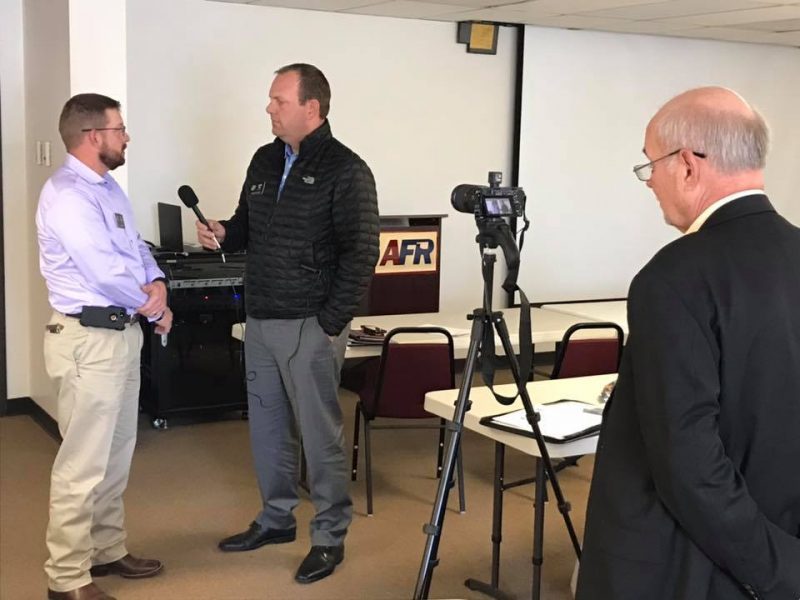
Our next speaker was Dr. Larry Sanders, professor and Extension economist, OSU Department of Agricultural Economics. He began by going over the political economy of the early President Trump years as well as economic indicators from a federal standpoint. He described the iron triangle of politics (congress, interest groups and administration), leading him to the main topic of our discussion, fragmentation of farm policies (the new farm bill and its struggles.) He also talked about how our economy works, new trade agreements for 2018 and tariffs on Oklahoma. He finished with a discussion on immigration in agriculture and emphasized how 1.5 million farm workers are needed to feed the growing population.
We then continued our discussion on the farm bill with Dr. Amy Hagerman, OSU Department of Agricultural Economics. She talked about the upcoming farm bill and how there are a lot of risks for production agriculture, but she was confident this farm bill will be passed (it was signed on Dec. 20, 2018).
Later that evening, we headed to the Great Hall of Gaylord – Pickens Museum, home of the Oklahoma Hall of Fame. We enjoyed a self-guided tour of the museum to learn about past Hall of Fame inductees as well as historical items on display. We also enjoyed a holiday dinner with OALP alumni and supporters at the museum.
Thursday, Dec. 6, 2018
We began the day at AFR. Dr. Rob Terry from OSU’s Department of Agricultural Communications, Education and Leadership led the morning as we delved into learning about our classmates’ strengths and personalities. Before this seminar, each class member completed the Jung Theory and StrengthsFinder tests. We brought our test results with us and Dr. Terry facilitated several activities for us to learn more about each other. Dr. Terry wrapped up the morning session with five key points: Know your talents; Take personal responsibility for developing talents into strengths; Make them part of your personal mission; Healthy, caring relationships for support; Put your talents into practice.
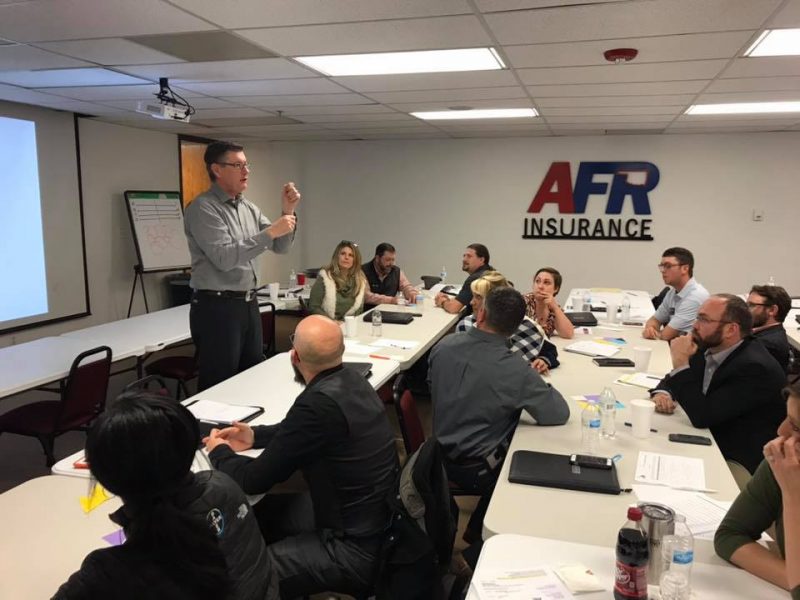
After lunch, Paul Jackson, AFR secretary/treasurer, spoke about the history of AFR and what it provides its members. AFR President Terry Detrick shared the benefits of AFR and some of the programs it offers.
We then left AFR and headed to the Regional Food Bank of Oklahoma for our community service project, where we assembled bags of food for the local backpack program for children. The backpack program feeds children in need of food over the weekend when they are not in school. It was a fun atmosphere where loud, fun music was played which motivated us to work hard. During our two-hour shift, we made 5,070 meals! After completing the project, Mason Weaver, Urban Harvest manager, gave us a tour of the Urban Harvest area of the Regional Food Bank. He explained his composting practices, use of red wiggler worms and the gardens they have at the Food Bank.
When we finished our tour of the Regional Food Bank, we joined each other for dinner at Ted’s Café Escondido and went back to the hotel for our Dirty Santa gift exchange.
Friday, Dec. 7, 2018
We gathered at AFR where we listened to one of the most influential speakers we will hear during our OALP participation. Alton Carter, director of youth ministries at First United Methodist Church in Stillwater and author of The Boy Who Carried Bricks, talked about failure to communicate.
He shared with us about why he wrote his books, his upbringing and those who positively impacted his life. Carter came from a rough life. His mom did drugs and his dad was nonexistent. He said he remembers times where he shared only a can of spinach for a meal with his five brothers and sisters. He also said he remembers the first time sleeping in an actual bed after he was removed from his mother’s custody. Even after moving in with his grandparents, he didn’t have a perfect life (alcohol, drugs and being forced to go with his uncle to beg for money).
Carter said he was a troubled kid at school, too. He had many teachers say they didn’t want him in their classes, until one day Ms. Thompson, a 4th grade teacher, said she would take him. Even though he continued to cause trouble, Ms. Thompson didn’t give up on him, and Carter said that is exactly what he needed. He continued to tell his story and we were in disbelief that many youth today have the same experiences as Carter’s. The moral of his story was to find your motivation and hang onto it. Even though he lived what seemed like a horrible life, he made the best of it and now he is happily married, has children and is a successful author and public speaker. One quote he said that we will remember is, “Sometimes when a heart is broken, it grows back crooked.”
We left AFR and headed to the National Weather Center in Norman where Wes Lee, OSU Mesonet agricultural program coordinator, greeted us. We discussed weather in agriculture and how the Oklahoma Mesonet functions alongside an overview of the NWC. We explored the Mesonet website and learned how to use the free tools provided online. We talked about Mesonet tower locations, what they measure (air temp, rainfall, wind speed, etc.) and how they are maintained. We also learned about how the Mesonet can help with soil temperature and planting. You can also look at past data and files to predict weather in the future.
After lunch, we enjoyed a tour of the NWC. We walked outside to see some weather vehicles and a Mesonet station. We toured the storm prediction center where they put out watches for storms. We also saw how they operate the center and how students learn how to become meteorologists.
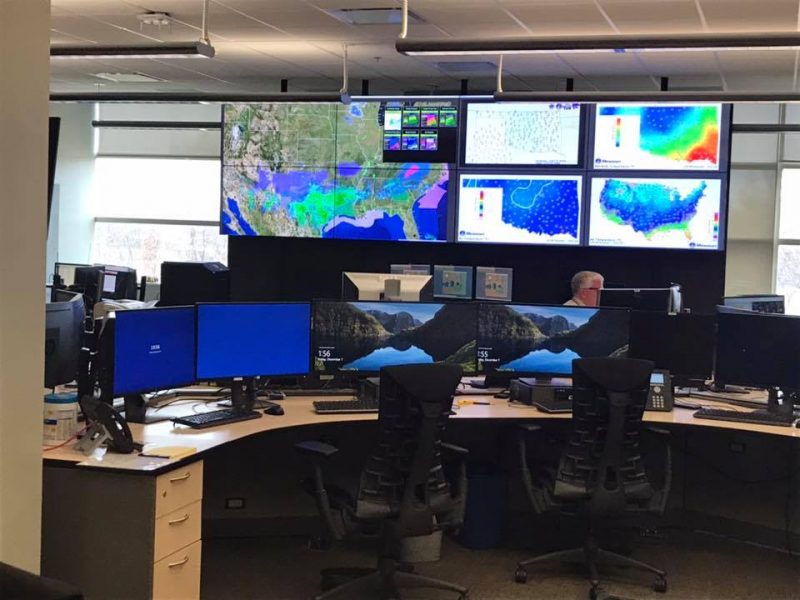
We wrapped up seminar four with reflections and announcements before loading up and heading back to our homes. The class will join again in mid-January to tour North Central Oklahoma and Kansas.
Best,
Kristin Young, Class XIX
OALP XIX Seminar 3
Oklahoma Agricultural Leadership Program met for the third time in Mid-Southern Oklahoma.
Wednesday, October 24
We began our third seminar at the OSU Institute of Agricultural Biosciences (IAB). Dr. Randy Allen spoke about the IAB and gave an overview of their focus and programs. They primarily focus on crop and genetic improvement but do have some weed science programs as well. Their research projects include leaf expansion, genetics of sorghum and chickpea, seed development and germination, development of cotton fibers – genetic ways to increase staple length, environmental stress tolerance, and herbicide efficacy testing.
They currently have a graduate program and coordinate coursework and exams with the Stillwater campus – teaching via video conference – and provide graduate programs for students working at the Noble Research Institute.
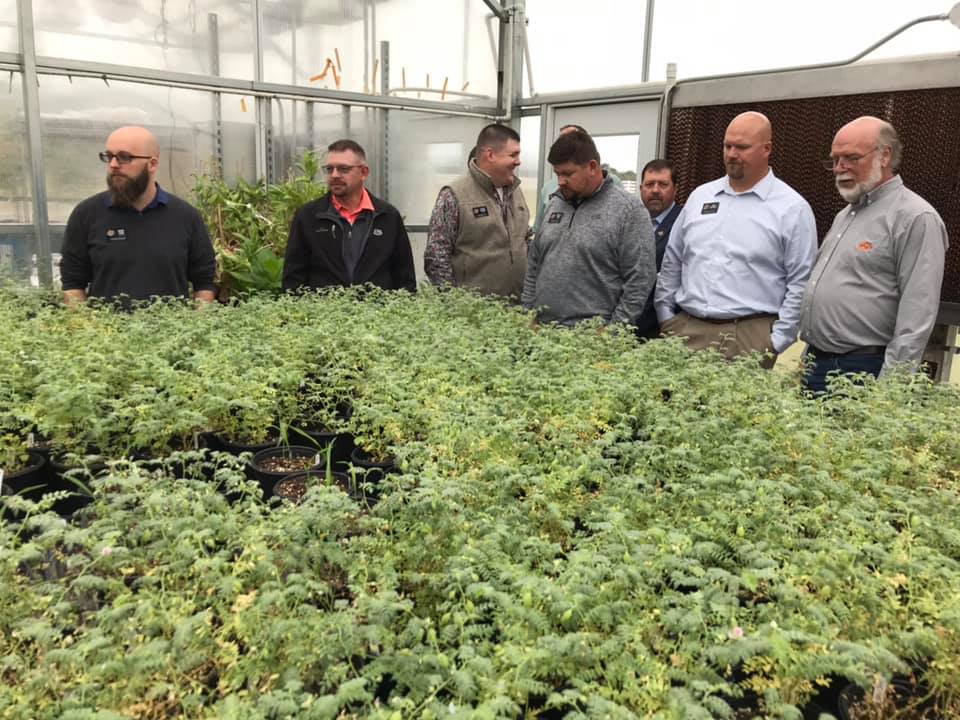
After the overview, we toured the office and lab. We viewed the greenhouse and internal growing plots, and looked at the heating and cooling system for the facility. The second group was cheated out of the opportunity to play ping pong and basketball.
During this third seminar, each member of the class was required to give a five minute oral presentation. Some of the presentations were given at IAB and some at the Noble Research Institute. Speakers and topics were:
Lindsey Henricks: Importance of using technology to share the story of agriculture
Nikki Schuth-Mitchell: Educating the American public about agriculture
Nina Wise: Importance of agricultural data
John Jeffrey: Educating the American public about agriculture
Johnathan Bergman: Transparency in agriculture
Dillon Payne: Problems with attracting and keeping young people in production agriculture
Jason Ramsey: Agricultural issues in Oklahoma
Zac Nulik: Marketing strategy in production agriculture
Adam Cobb: The future of food is soil health
Jake Harriger: Glyphosate – does it cause cancer…. you decide
Courtney Brown: Ethnic diversity of agriculture
Eli Parr: Importance of precision agriculture and its role in modern farming practices
James Ambrose: Impact of 4-H and FFA organizations across the youth of America
Mark Zordel: Labor issues facing agriculture
Dillon Sparks: Disruptive selection in beef cattle – cow size and milk production
Myriah Johnson: Traceability in the beef industry
Reid Nichols: Importance of the “telling the story of agriculture” to newly elected officials
Steven Stewart: Challenges facing rural families and their way of life
Lee Vanderwork: ELD’s and how it is going to affect the agriculture industry
Kendal Henderson: Women in agriculture
Tandy Kidd: Why Oklahoma agriculture should be concerned about globalization
Gregg Pickens: Product of production agriculture and real estate/auction business
Allan Poe: Farm transitions
After touring the IAB, we went to the Noble Research Institute (NRI) and learned about their vision and focus from Adam Calaway. The Noble Research Institute began in 1896. They started the Samuel Roberts Noble Foundation with a simple mission – Take Care of the Soil.
Lloyd Noble passed away in 1950 and left the bulk of $10 million to the Noble Foundation. Today, the Noble Research Institute employs almost 400 people. Of those, over 100 have Ph.D. degrees.
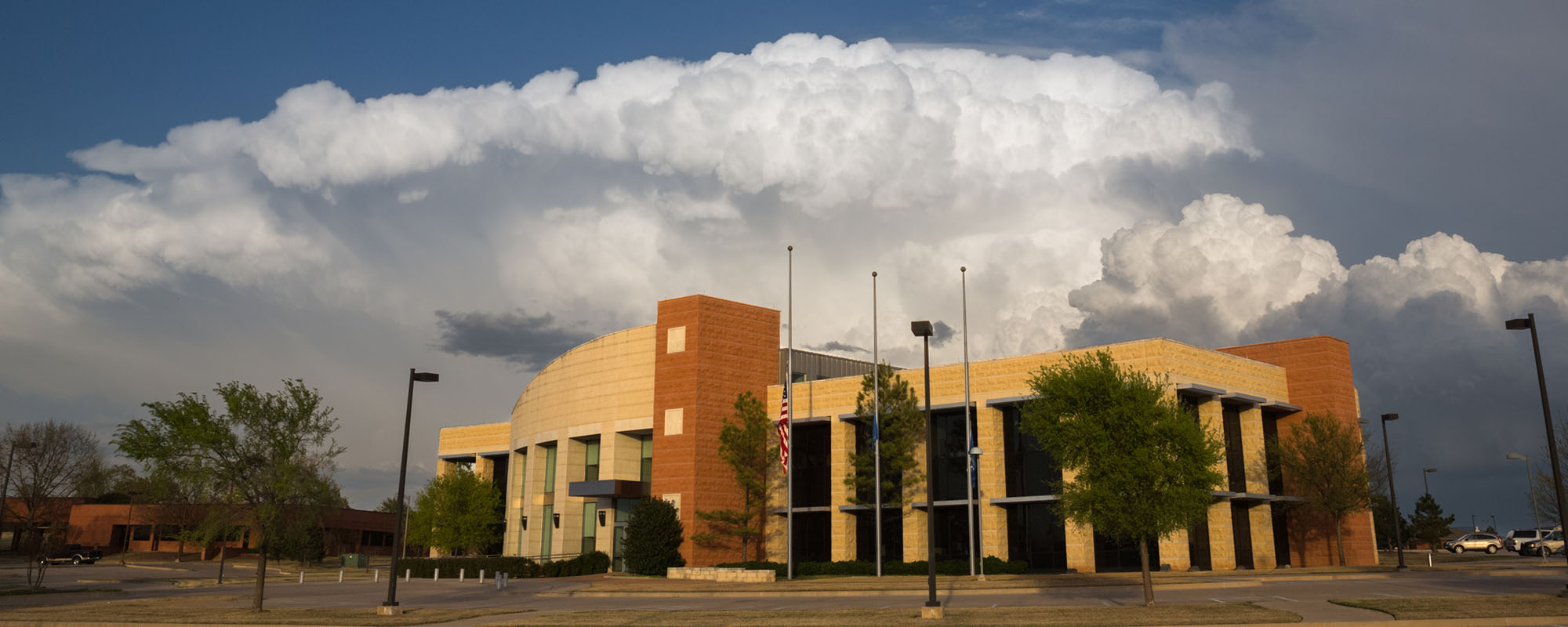
The NRI focuses on Four Core Areas: 1.) Producer Relations – no cost process. “What are your goals?” Help them achieve those goals through good land management practices and stewardship. 2.) Education – Noble Academy. The Academy helps show the value of agriculture to their life and how important research is in the process, which includes talking about agriculture professional opportunities. There is also a Noble Learning Center – backyard farming and gardening and inspiring urban agriculture. 3.) Research – focused on areas other than commodity crops that already have a lot of research being performed. 4.) Applied agricultural systems research and technology – seven research farms spread across Oklahoma covering about 13,500 acres. They perform testing to see if technology makes economic sense.
The NRI has collaborations with universities, industries, non-profit organizations, and government entities. A transition occurred and the Noble Foundation split into the Noble Research Institute and Noble Foundation on May 1, 2017. The organization became a non-profit public charity and created a new private foundation to be the parent with the old name attached. The Noble Foundation gives grants to the Noble Research Institute. They do have additional funding sources through grants, but the bulk on the money for the Noble Research Institute comes from the Noble Foundation.
While at the NRI, we toured their greenhouse facility where they have 50,000 square feet in one single greenhouse. It is one of the largest (if not the largest) single private greenhouses in the U.S.
We also had the opportunity to listen to Dr. Elison Blancaflor give a presentation on Microscopy in Agriculture. He talked about the advances in microscopy and new technology. They focus on root science – asking very basic questions and searching for the reasons why. Root hairs account for 50% of water uptake and 80% of phosphorus uptake. Root hairs improve root penetration into hard compact soils.
There are three main reasons why light microscopy has undergone a revolution: 1.) Better equipment – digital light – allows us to see in new ways, 2.) new ways to label cells and cell parts, and 3.) image processing. One cool fact we learner was that the second to the last space shuttle carried the first of two NRI plant experiments. Studying plants in space is important for future space travel and potential space colonies – plants were able to grow in space. Roots grew in a singular spiral fashion.
Following Dr. Blancaflor, Dr. Charles Rohla talked about some of the specialty agriculture programs they have going on at the NRI. CPSA has been established to conduct research and demonstrations that will not only enhance production but educate producers and the community about the opportunities in specialty agriculture. Their focus is to demonstrate different concepts and systems that a producer can incorporate into their operations regardless of operation size. Their goals are to:
1.) Develop partnerships to provide education opportunities, 2.) Provide high quality education and demonstrations, 3.) Conduct research to enhance understanding, development, and management strategies to increase efficiency and profitability, and 4.) Develop and promote technology that can be used to increase efficiency.
After checking in to the NRI Conference Center, we had a nice meal followed by a presentation in which Hugh Aljoe gave an overview of producer relations. Later in the evening, Lauren Cline interviewed a few class members about desired employability skills for new graduates with agriculture degrees.
Thursday, October 25
Amy Hays started off our Thursday experience. Amy has been with NRI for three years and is in charge of Adult Education – informal setting. One of the main challenges – coming up with ways to be more efficient with education and create a bigger impact. The program that they try to work towards is a competency based evaluation of what producer needs. They conduct a lot of research and collaborate with other industries to increase awareness of adult education, informal science education centers, etc. Two methods that they are currently using are 1.) Education progression – progression based learning over time to achieve different skill sets and 2.) System education – show and tell, demonstration, conferences, seminars, coordinating resources, and peer learning communities. Retention of information is much higher with peers than with education progression. There is a 10 month planning process for any new meeting.
Next we went to the forage sensors and technology session with Justin Hoffman and Dillion Payne. Justin has been with NRI for three years where his main focus is agriculture sensors and creating a product that can be validated. He is currently working on sensors that can estimate tonnage and quality in a monoculture cropping system on a large scale. They already have a SPIDER that is equipped with these sensors. The SPIDER is a small row crop unit that is used to measure biomass in small plot research. The ultimate goal is to have full autonomy on the farm. Dillion Payne took over and talked about his work with drones and sensors. He is really passionate about helping farmers and being able to make their lives easier. He showed us a drone that could collect NDVI (Normalized Difference Vegetative Index) and RGB (Red, Green Blue) color spectrum. Our discussion led to things of the future and the endless possibilities.
Moving across the building, we met with Dr. James Rogers who is working on summer grazing cover crops and also having winter pasture. They are also conducting research on conventional till and no till, and have plots of conventional till no cover crop and no till no cover crop to make sure it’s working. They are collecting moisture and temperature on all the plots. Utilizing the Hainey Test, they are testing soil health, also. The cover crop consists of 50% millet and 50% broadleaves. Crabgrass is the main issue for being competition for the covers. Dr. Kelly Craven was not able to meet with us but we heard from Dr. Venkatachalam Lakshmanan AKA Vinky, and the research he is doing. He is focused on soil biology and health. He is researching the bacterial and fungi relationship between No Till (NT) and Conventional Till (CT). From his findings, the NT has a more diverse set of bacteria and higher rates of fungi. The CT has lower fungi and higher rates of individual bacteria. He is conducting some research introducing fungi into the NT and CT systems to see if it will change some of results he is finding or if natural selection will attack the introduced fungi.
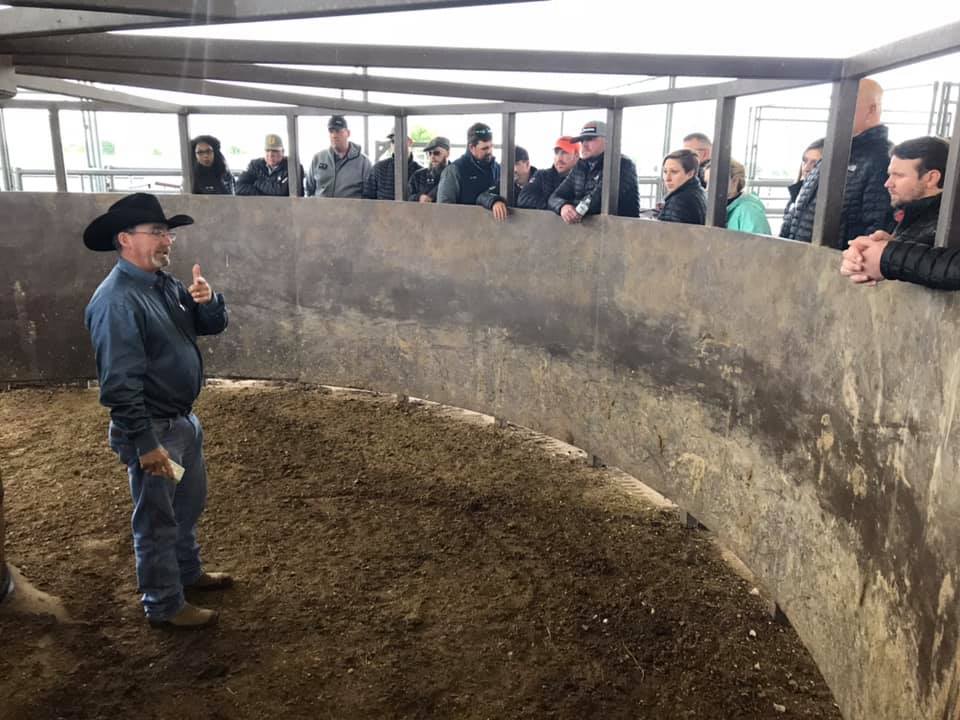
After arriving at the Oswalt Ranch, Dr. Billy Cook presented on the need for research of the technology that has been flooding the market. Is it valid, does it work, does it take care of natural resources, is it economically viable and ecosystem functional are some of the questions they ask about the technology, and then answer the questions through research. Wanting the NRI experience for the producers they work with to be tailor made, the main thing they focus on are the goals of the producer.
Classmate Dr. Myriah Johnson presented on the programs that NRI and different entities are involved with in industry pilot projects, the challenges facing those types of programs, and the advantages of the programs. The purpose of the programs is to engage target sectors within the agricultural industry, and advance sound knowledge and policies for agriculture and land resources. The program provides educational events for politicians, and as we have many new senators and representatives the need for this type of education is very important.
The programs look for different ways for producers to create value in the cattle market. There are currently two different pilot programs:
1.) Land Stewardship Program – Being able to package and verify what producers are doing on the cropping systems side. Looking to establish a method of capturing the information so that when the program is going, the sources (General Mills, Cargill, etc.) will have a way to track progression. Between 2022-2024 looks like the timeline for program implementation.
2.) Integrity Beef Pilot Program – Establish supply chain and have the ability to track sources of beef from birth to edible product and everything in between. They have created a round table of industry personnel to collaborate on how to implement more vertical integration, but with many different companies it creates its own challenges. Many companies say they want it but are not willing to go all in with information and carry on the torch within their own company. Currently, producers are not getting docked for not monitoring and documenting cattle vaccinations – they just receive a premium if they do.
Devlon Ford has been with NRI for nine years mainly working with cattle. We began in the cattle handling facility, and talked about the design and capacity of the facility. The main thing that Devlon stressed was that everything was built with safety in mind, not only for the workers but also for the cattle. He gave a demonstration with live cattle about how the facility works. Since it is a research facility the cattle will be in the facility multiple times per month, and they need to not be stressed to come in. They run 1500-1800 head of cattle through the facility annually but with multiple times through it’s hard to know an accurate number. Throughout the entire NRI, they run 10,000 head through facilities across their land. We also talked about methods of record keeping. The NRI uses EID tags as well as newer technology that emits an Ultra High Frequency (UHF). This technology is something they are working on to be able to read with a sensor from a drone. Next, we moved on to Whispering Lung Technology. This is a stethoscope based sensor that communicates back to a computer that puts data through algorithms to see if an animal is prone to respiratory infections. It is a tool that they utilize on the farm as well. Classmate Courtney Brown was able to take this technology for a spin and demonstrated for the class. We then walked over to the area where they have a GrowSafe system that is used for weighing feed consumption and water utilization. It is a high-tech system that is helpful to the grower in maintaining a healthy herd.
Classmate Dillion Payne and Tresa Trammell explained the rules and regulations that come with operating a drone. They provided each member of the class a chance to operate a drone and provided personalized instruction during operation. Dillion was kind enough to take a class photo using the drone.
Jeff Moen has been with NRI for 12 years. He is a lawyer and head of licensing for commercializing research outcomes. He also finds new technology as well to bring to the table. One of the main duties is vetting the new technology and sorting through what can come to market and what is just an idea.
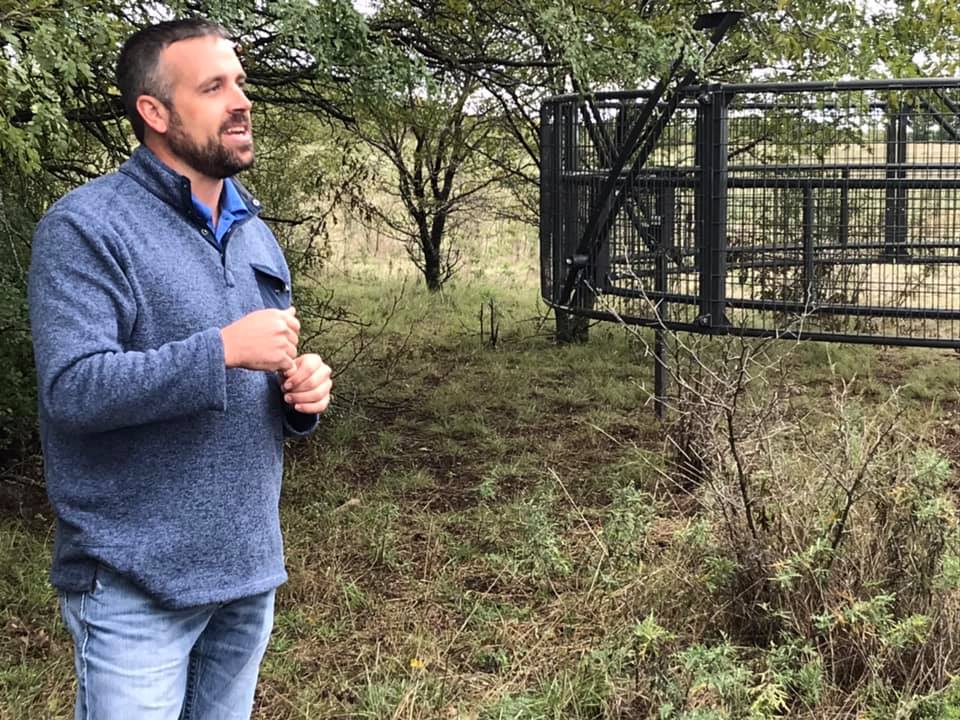
Josh Gaskamp has been with NRI for 12 years and his focus is on wildlife. He was conducting some research with GPS tagging of white tail deer and realized that they could take the same concept and apply it to trapping feral hogs. Josh explained how natural selection has been taking place with feral hogs and the need for the BoarBuster has been around. It is now an affordable tool and can be used to take out more than 80% of the populations when done correctly.
Class XIX went to the University of Southern Oklahoma campus and to help with several projects. One team headed up landscaping of the new sign near the entrance. Another team headed up erosion control for a small pond by reinforcing a spillway with rocks. Another team helped in planning future walking and biking trails that will wind through the campus land and tie into existing trails with the city’s trails.
A potluck dinner at the OSU Institute for Agricultural Biosciences with OALP alumni was a chance to meet people that have been through the OALP experience and to hear about their experiences with their classes. They shared a lot of memories and reflections of their experience locally and internationally.
Friday, October 26
After breakfast, we drove to Madill and were greeted upon arrival by Mr. Johnny Raper of Oklahoma Steel and Wire. He gave us a brief history of the facility and then we drove to the east side where we were fitted with safety gear and given instructions. We divided into smaller groups and started the tour where the scrap iron is taken from raw material and melted and transformed into a steel billet that then is transported to the other side of the plant where it is made into a variety of products including barbed, woven, smooth, and welded wire panels. These products then go to distribution where they are shipped to various vendors. The tour was very informative and eye-opening and the folks from OK Wire were super hosts. They treated us to a pizza lunch following the three hour tour. We then departed for home after lunch.
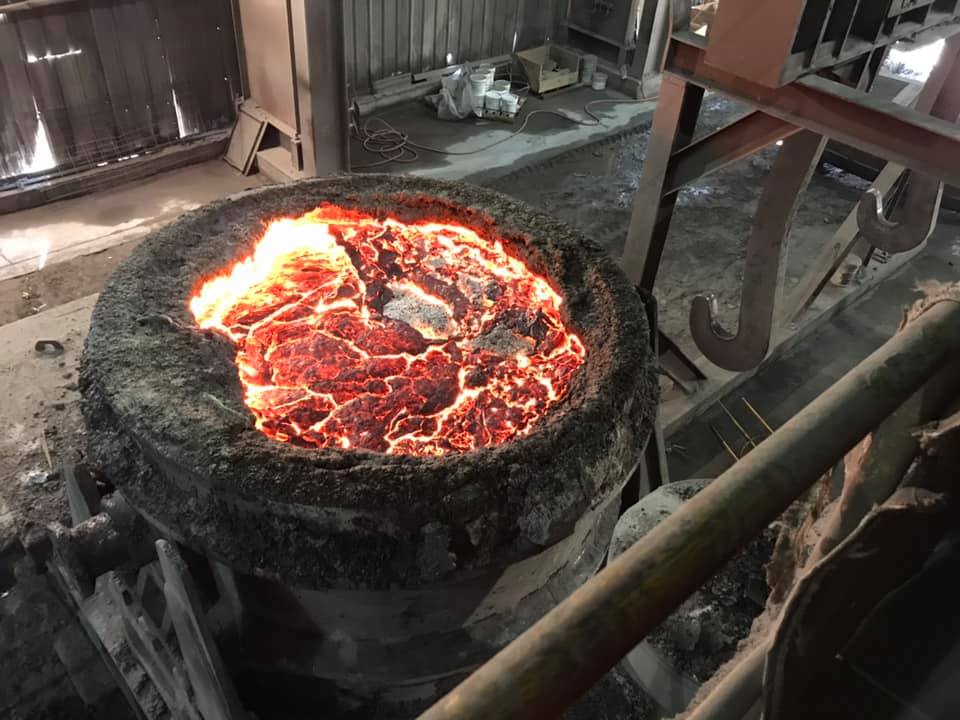
The third seminar allowed Class XIX to learn more about the diversity of Oklahoma’s agriculture industry. We anticipate more adventures at our next seminar!
Best,
Courtney P. Brown, Class XIX